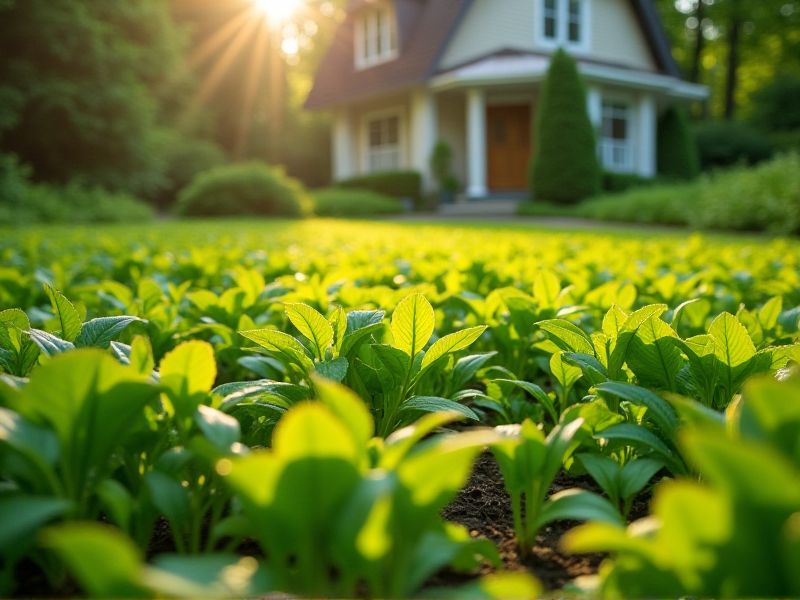
Heat-resistant groundcover plants are essential for maintaining vibrant landscapes in warm climates. Varieties such as sedum, with its succulent leaves, thrive in full sun and require minimal water, making them ideal for dry gardens. Lantana provides colorful blooms and attracts pollinators, while also withstanding drought conditions. Another excellent choice is creeping thyme, a fragrant herb that forms dense mats and can tolerate foot traffic, providing both aesthetics and functionality. With these selections, you can create an environmentally friendly, low-maintenance garden that endures the heat.
List of some Groundcover plants that resist heat
- Blue Star Creeper (Isotoma fluviatilis)
- Creeping Thyme (Thymus serpyllum)
- Woolly Yarrow (Achillea tomentosa)
- Bugleweed (Ajuga reptans)
- Sedum (Sedum spp.)
- Moss Rose (Portulaca grandiflora)
- Dwarf Mondo Grass (Ophiopogon japonicus 'Nana')
- Bearberry (Arctostaphylos uva-ursi)
- Liriope (Liriope muscari)
- Lamb's Ear (Stachys byzantina)
Important things about Groundcover plants that resist heat
Heat Tolerance Levels
Groundcover plants that exhibit heat tolerance play a vital role in sustainable landscaping, particularly in arid and semi-arid regions. Varieties such as Sedum, Purple Heart (Tradescantia pallida), and Lantana are well-known for their ability to thrive under high temperatures while requiring minimal water. These plants not only enhance aesthetic appeal but also contribute to soil erosion control and urban heat island mitigation. Selecting heat-resistant groundcover can significantly reduce maintenance efforts and water consumption in your garden or landscape design.
Watering Requirements
Groundcover plants that resist heat typically require less frequent watering compared to traditional lawns. Deep-rooted varieties, such as sedum and thyme, thrive in full sun and often only need irrigation during prolonged dry spells. Mulching can further enhance moisture retention in the soil, allowing these resilient species to flourish even in arid conditions. By choosing drought-tolerant groundcovers, you can create a low-maintenance landscape that conserves water while still providing aesthetic value.
Soil Type Preference
Groundcover plants that resist heat thrive best in well-drained, sandy or loamy soil, which allows for efficient water retention while preventing root rot. Varieties such as creeping thyme and sedum prefer slightly acidic to neutral soils, making them ideal for xeriscaping in hot climates. To enhance drought resistance, incorporate organic matter into the soil to improve its structure and moisture-holding capacity. Selecting the right soil type not only supports the health of your chosen groundcovers but also promotes a sustainable landscape resistant to extreme temperatures.
Growth Habits
Groundcover plants that resist heat are essential for sustainable landscaping, particularly in arid regions. Varieties such as creeping thyme, sedum, and blue star creeper thrive in high temperatures while minimizing water requirements. These resilient plants not only reduce soil erosion but also provide visual interest with their vibrant colors and textures. By incorporating heat-tolerant groundcovers into your garden, you can create a low-maintenance landscape that conserves water and supports local biodiversity.
Sunlight Exposure Needs
Groundcover plants that thrive in sunlight and resist heat are essential for maintaining a vibrant garden during the summer months. Varieties such as Creeping Thyme, Sedum, and Lantana not only withstand high temperatures but also require minimal water input, making them ideal for drought-prone areas. These resilient plants provide lush coverage, helping to inhibit weed growth and conserve soil moisture. By incorporating these heat-tolerant groundcovers in your landscape, you can create a low-maintenance and visually appealing outdoor space.
Maintenance Practices
Groundcover plants that resist heat, such as sedum, thyme, and native grasses, provide an excellent low-maintenance option for drought-prone gardens. These resilient plants not only minimize water usage but also reduce soil erosion, making them ideal for sustainable landscaping. Regularly checking the soil moisture and applying organic mulch can enhance their heat resistance while promoting healthy growth. By incorporating these hardy groundcovers, you can create a vibrant landscape that thrives even in the hottest conditions.
Pest And Disease Resistance
Groundcover plants that exhibit heat resistance are essential for maintaining vibrant landscapes in warmer climates. Varieties like Sedum and Zoysia grass not only thrive in high temperatures but also demonstrate remarkable pest resistance, reducing the need for chemical interventions. These plants can help control soil erosion while providing a lush, green alternative to traditional lawns. Choosing the right heat-resistant groundcovers for your garden ensures enduring beauty with minimized maintenance and ecological impact.
Aesthetic Appeal
Groundcover plants that resist heat not only enhance your landscape's aesthetic appeal but also provide crucial environmental benefits. Varieties such as Sedum, Lantana, and thyme are known for their vibrant colors and textures, thriving even in high temperatures while requiring minimal water. These low-maintenance plants effectively suppress weeds, reduce soil erosion, and can attract beneficial pollinators like bees and butterflies to your garden. By incorporating heat-resistant groundcovers, you can create an eye-catching, sustainable oasis that flourishes in warmer climates.
Environmental Benefits
Groundcover plants, such as creeping thyme, sedum, and moss, play a crucial role in enhancing environmental sustainability by reducing soil erosion and improving soil health. These plants are particularly beneficial in hot climates, as they possess heat-resistant qualities that allow them to thrive with minimal water, thus conserving precious water resources. By covering the soil, they also suppress weed growth, reducing the need for chemical herbicides and promoting a healthier ecosystem. When you choose heat-resistant groundcovers for your landscape, you not only create a vibrant garden but also contribute to biodiversity and decrease your carbon footprint.
Common Varieties
Groundcover plants that resist heat are essential for maintaining a vibrant landscape in arid or warm regions. Varieties like Sedum, often called stonecrop, exhibit drought tolerance and thrive in sunny, dry conditions, making them an excellent choice for rock gardens. Another popular option, Lantana, not only withstands high temperatures but also attracts butterflies with its colorful blooms. Native plants such as Verbena and Creeping Thyme further enhance heat resistance while providing a lush, green carpet that reduces water usage in your garden.
